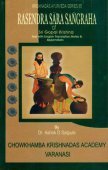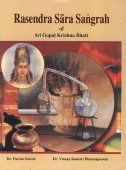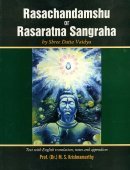Visarpa: 20 definitions
Introduction:
Visarpa means something in Buddhism, Pali, Hinduism, Sanskrit, Jainism, Prakrit. If you want to know the exact meaning, history, etymology or English translation of this term then check out the descriptions on this page. Add your comment or reference to a book if you want to contribute to this summary article.
In Hinduism
Ayurveda (science of life)
Rasashastra (Alchemy and Herbo-Mineral preparations)
Source: archive.org: Rasa-Jala-Nidhi: Or Ocean of indian chemistry and alchemyVisarpa (विसर्प) refers to “erysipelas”. (see the Rasajalanidhi by Bhudeb Mookerji volume 3)
Cosmetics, Perfumery, Skin care and other Ayurvedic Beauty treatments
Source: Ancient Science of Life: Critical review of Ayurvedic Varṇya herbsVisarpa (विसर्प) refers to “erysipelas” (a type of skin disease).—In Ayurveda, pitta and rakta vitiation are held responsible for impairment of skin health, lustre, colour as well as complexion and skin diseases such as visarpa (erysipelas), vyaṅga (melasma), śvitra (leucoderma), dadru (urticaria), pippalu (moles) to name a few, therefore herbs alleviating these two will act as skin lightening agents. [...] A few among them act indirectly as varṇya by alleviating rakta and pitta doṣa
Kalpa (Formulas, Drug prescriptions and other Medicinal preparations)
Source: Shodhganga: Edition translation and critical study of yogasarasamgrahaVisarpa (विसर्प) refers to “erysipelas” and is one of the various diseases mentioned in the 15th-century Yogasārasaṅgraha (Yogasara-saṅgraha) by Vāsudeva: an unpublished Keralite work representing an Ayurvedic compendium of medicinal recipes. The Yogasārasaṃgraha [mentioning visarpa] deals with entire recipes in the route of administration, and thus deals with the knowledge of pharmacy (bhaiṣajya-kalpanā) which is a branch of pharmacology (dravyaguṇa).
Unclassified Ayurveda definitions
Source: Wisdom Library: Āyurveda and botanyVisarpa (विसर्प) refers to “erysipelas”, but more specifically, it is a subcutaneous tissue disease which spreads very fast and is characterized by inflammation of the skin and tissue and by fevers. It is used throughout Ayurvedic literature such as the Caraka-saṃhitā and the Suśruta-saṃhitā. The Sanskrit compound Visarpa is composed of the prefix Vi and the word Sarpa, literally meaning “snake”.
Source: archive.org: Sushruta samhita, Volume IIThe deranged and aggravated Doshas, (Váyu, Pittam and Kapham) having recourse to, and affecting the Tvaka (Skin), flesh and blood, speedily give rise to a sort of shifting, elevated swelling (Sotha) marked by the characteristic symptoms of any of them involved in the case. This swelling tends to extend all over the body. The disease is called Visarpa from the fact of its extending or swiftly shifting character (Skr. srip–to go, to extend).
Source: archive.org: Vagbhata’s Ashtanga Hridaya Samhita (first 5 chapters)Visarpa (विसर्प) refers to “erysipelas,”, mentioned in verse 4.18 of the Aṣṭāṅgahṛdayasaṃhitā (Sūtrasthāna) by Vāgbhaṭa.—Accordingly, “[...] Erysipelas [viz., visarpa], urticaria, leprosy, itching of the eyes, jaundice, and fever as well as cough, dyspnea, palpitation of the heart, freckles of the face, and swellings of the skin (result) from (suppressed) vomiting. A gargle, an inhalant, a fast, after one has eaten pungent (food)—its ejection, gymnastics, a bloodletting, and a purgative (are) commended in this case”.
Source: eJournal of Indian Medicine: Memoirs of Vaidyas (3)Visarpa literarily means ‘spreading’ in Sanskrit and is a term of a disease or symptom in Āyurveda. It includes erysipelas and some similar spreading eruptions.
Source: Research Gate: Internal applications of Vatsanabha (Aconitum ferox wall)Visarpa (विसर्प) refers to “erysipelas” (a form of cellulitis that affects only the top layers of the skin). Vatsanābha (Aconitum ferox), although categorized as sthāvara-viṣa (vegetable poisons), has been extensively used in ayurvedic pharmacopoeia.

Āyurveda (आयुर्वेद, ayurveda) is a branch of Indian science dealing with medicine, herbalism, taxology, anatomy, surgery, alchemy and related topics. Traditional practice of Āyurveda in ancient India dates back to at least the first millenium BC. Literature is commonly written in Sanskrit using various poetic metres.
Shaivism (Shaiva philosophy)
Source: SOAS University of London: Protective Rites in the Netra TantraVisarpa (विसर्प) or Visarpa refers to “skin diseases”, according to the Netratantra of Kṣemarāja: a Śaiva text from the 9th century in which Śiva (Bhairava) teaches Pārvatī topics such as metaphysics, cosmology, and soteriology.—Accordingly, [verse 19.121-128, while describing the prevention of natural disasters]—“[...] [He performs the ritual when people are afflicted by] skin diseases, etc., fevers, untimely death or various sorts of pain, past faults or seizing spirits. Diseases from snake poison, etc., insect bites, etc., rheumatism, change in form, phlegm, hemorrhoids, eye diseases, skin diseases, etc. (visarpa—visarpakādayaḥ), internal disease, and sickness caused by wounds, etc., by the thousands [can occur] if various sorts of evils touch the Maṇḍala, a defect arises from offense [occurs]. [...]”.

Shaiva (शैव, śaiva) or Shaivism (śaivism) represents a tradition of Hinduism worshiping Shiva as the supreme being. Closely related to Shaktism, Shaiva literature includes a range of scriptures, including Tantras, while the root of this tradition may be traced back to the ancient Vedas.
In Buddhism
Tibetan Buddhism (Vajrayana or tantric Buddhism)
Source: Wisdom Library: Tibetan BuddhismVisarpa (विसर्प) refers to one of the male Vidyā-beings mentioned as attending the teachings in the 6th century Mañjuśrīmūlakalpa: one of the largest Kriyā Tantras devoted to Mañjuśrī (the Bodhisattva of wisdom) representing an encyclopedia of knowledge primarily concerned with ritualistic elements in Buddhism. The teachings in this text originate from Mañjuśrī and were taught to and by Buddha Śākyamuni in the presence of a large audience (including Visarpa).

Tibetan Buddhism includes schools such as Nyingma, Kadampa, Kagyu and Gelug. Their primary canon of literature is divided in two broad categories: The Kangyur, which consists of Buddha’s words, and the Tengyur, which includes commentaries from various sources. Esotericism and tantra techniques (vajrayāna) are collected indepently.
In Jainism
General definition (in Jainism)
Source: Encyclopedia of Jainism: Tattvartha Sutra 5: The category of the non-livingVisarpa (विसर्प, “contraction”) according to the 2nd-century Tattvārthasūtra 5.16.—How does the empirical soul with innumerable space point exist in one of the innumerable space-points of space? It is possible due to the capacity of expansion (saṃhāra) and contraction (visarpa) of the soul, like light. The empirical soul is of the size of the body it owns according to this capacity of expansion and contraction.
Is contraction (saṃhāra) and expansion (visarpa) nature of the soul or is it an attribute of kārmika bondage? Contraction expansion is not the nature of the sol. It is an attribute of the name karma associated with the soul. Do Siddhas have expansion and contraction? If not, why not? No, as they (Siddhas) is free from body-making karma. Contraction and expansion is an attribute of karma and not of the soul.

Jainism is an Indian religion of Dharma whose doctrine revolves around harmlessness (ahimsa) towards every living being. The two major branches (Digambara and Svetambara) of Jainism stimulate self-control (or, shramana, ‘self-reliance’) and spiritual development through a path of peace for the soul to progess to the ultimate goal.
Languages of India and abroad
Sanskrit dictionary
Source: DDSA: The practical Sanskrit-English dictionaryVisarpa (विसर्प).—
1) Creeping about, gliding.
2) Moving to and fro.
3) Spread, circulation; किमु विषविसर्पः किमु मदः (kimu viṣavisarpaḥ kimu madaḥ) Uttararāmacarita 1.36.
4) An unexpected or unwished-for consequence of an act.
5) A sort of disease, dry spreading itch; लवणाम्लकटूष्णादिसेवनाद्दोषकोपतः । विसर्पः सप्तधा ज्ञेयः सर्वतः परिसर्पणात् (lavaṇāmlakaṭūṣṇādisevanāddoṣakopataḥ | visarpaḥ saptadhā jñeyaḥ sarvataḥ parisarpaṇāt) ||
Derivable forms: visarpaḥ (विसर्पः).
Source: Cologne Digital Sanskrit Dictionaries: Shabda-Sagara Sanskrit-English DictionaryVisarpa (विसर्प).—m.
(-rpaḥ) 1. Spreading. 2. Going. 3. Going variously. 4. Flying, gliding. 5. Unwished consequence of any act. 6. Erysipelatous inflammation. E. vi before sṛp to go, ghañ aff.
Visarpa can also be spelled as Vīsarpa (वीसर्प).
Source: Cologne Digital Sanskrit Dictionaries: Benfey Sanskrit-English DictionaryVisarpa (विसर्प).—i. e. vi-sṛp + a, m. 1. Spreading, [Uttara Rāmacarita, 2. ed. Calc., 1862.] 23, 6. 2. Flying, gliding. 3. Going. 4. Unwished consequence of any act.
Source: Cologne Digital Sanskrit Dictionaries: Cappeller Sanskrit-English DictionaryVisarpa (विसर्प).—[masculine] spreading about, a kind of inflammation (also pikā [feminine]).
Source: Cologne Digital Sanskrit Dictionaries: Monier-Williams Sanskrit-English Dictionary1) Visarpa (विसर्प):—[=vi-sarpa] [from vi-sṛp] m. creeping along or about, spreading, diffusion, [Uttararāma-carita; Śāntiśataka] ([varia lectio])
2) [v.s. ...] a [particular] disease (erysipelas or any similar spreading eruption), [Suśruta]
3) [v.s. ...] (in [dramatic language]) an action which leads to an unhappy or undesired issue (e.g. [Veṇīs. iii, 10]), [Sāhitya-darpaṇa]
4) Vīsarpa (वीसर्प):—[=vī-sarpa] m. = vi-s, [Caraka]
Source: Cologne Digital Sanskrit Dictionaries: Yates Sanskrit-English DictionaryVisarpa (विसर्प):—[vi-sarpa] (rpaḥ) 1. m. Gliding; spreading; flying; unpleasant result; inflammatory eruption.
Source: DDSA: Paia-sadda-mahannavo; a comprehensive Prakrit Hindi dictionary (S)Visarpa (विसर्प) in the Sanskrit language is related to the Prakrit word: Visappa.
[Sanskrit to German]
Sanskrit, also spelled संस्कृतम् (saṃskṛtam), is an ancient language of India commonly seen as the grandmother of the Indo-European language family (even English!). Closely allied with Prakrit and Pali, Sanskrit is more exhaustive in both grammar and terms and has the most extensive collection of literature in the world, greatly surpassing its sister-languages Greek and Latin.
Kannada-English dictionary
Source: Alar: Kannada-English corpusVisarpa (ವಿಸರ್ಪ):—
1) [noun] the act of spreading; diffusion.
2) [noun] an acute infectious disease of the skin or mucous membranes caused by a streptococcus and characterised by local inflammation and fever; erysipelas.
3) [noun] a chronic disease characterised by the enlargement of the legs, and by the hardening and ulceration of the surrounding skin; elephantiasis.
Kannada is a Dravidian language (as opposed to the Indo-European language family) mainly spoken in the southwestern region of India.
See also (Relevant definitions)
Starts with: Visarpacikitsa, Visarpaghna, Visarpaka, Visarpakhinnavigraha, Visarpan, Visarpana, Visarpani, Visarpaprada, Visarparoga, Visarpat.
Ends with: Agnivisarpa, Granthivisarpa, Kardamavisarpa, Mandavisarpa.
Full-text (+15): Visarpin, Agnivisarpa, Visarpika, Visarpaghna, Vaisarpa, Visappa, Sritvan, Visarpana, Visarpakhinnavigraha, Kshataja, Visarpacikitsa, Parisarpa, Vaisarpika, Visarparoga, Kardamavisarpa, Visarpaka, Granthivisarpa, Kshatakrita, Udarda, Visarpini.
Relevant text
Search found 16 books and stories containing Visarpa, Vīsarpa, Vi-sarpa, Vī-sarpa; (plurals include: Visarpas, Vīsarpas, sarpas). You can also click to the full overview containing English textual excerpts. Below are direct links for the most relevant articles:
Sushruta Samhita, volume 2: Nidanasthana (by Kaviraj Kunja Lal Bhishagratna)
Chapter X - Diagnosis of erysipelas, sinus and mammae
Atharvaveda and Charaka Samhita (by Laxmi Maji)
Visarpa (erysipelas) according to Caraka < [Chapter 4 - Diseases and Remedial measures (described in Caraka-saṃhitā)]
Treatment of Visarpa disease < [Chapter 3 - Diseases and Remedial measures (described in Atharvaveda)]
Classification of diseases in the Caraka-Saṃhitā < [Chapter 4 - Diseases and Remedial measures (described in Caraka-saṃhitā)]
Charaka Samhita (English translation) (by Shree Gulabkunverba Ayurvedic Society)
Chapter 21 - The therapeutics of Acute Spreading Affections (visarpa-cikitsa) < [Cikitsasthana (Cikitsa Sthana) — Section on Therapeutics]
Chapter 19 - The Eight Abdominal affections (udara-roga) < [Sutrasthana (Sutra Sthana) — General Principles]
Sahitya-kaumudi by Baladeva Vidyabhushana (by Gaurapada Dāsa)
Text 7.149 < [Chapter 7 - Literary Faults]
Sushruta Samhita, volume 4: Cikitsasthana (by Kaviraj Kunja Lal Bhishagratna)
Chapter XVII - The medical treatment of erysipelas
Chapter XX - The medical treatment of the minor ailments
Jivanandana of Anandaraya Makhin (Study) (by G. D. Jayalakshmi)
Diseases related to Sapta-dhātus and their cure < [Chapter 4 - Āyurvedic principles in Jīvanandana Nāṭaka]
Related products



